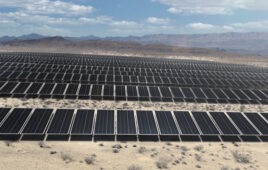The U.S. Dept. of the Treasury and Internal Revenue Service (IRS) recently announced that more than 1,000 projects have registered through the new IRS Energy Credits Online (ECO) portal for new direct pay and transferability credit monetization provisions as established in the Inflation Reduction Act.
The two new credit delivery mechanisms — elective pay (direct pay) and transferability — enable state, local and Tribal governments; non-profit organizations; U.S. territories; and other entities to take advantage of clean energy tax credits. Until the Inflation Reduction Act introduced these new credit delivery mechanisms, many types of tax-exempt organizations and some businesses could not fully benefit from tax credits like those that incentivize clean energy construction.

Credit: EightTwenty
“Increased access to clean energy credits is acting as a force multiplier so that more clean energy projects are built quickly and affordably, and more communities benefit from the growth of the clean energy economy,” said Deputy Secretary of the Treasury Wally Adeyemo. “Making it easy to access these credits also underscores the connection between realizing the economic and climate goals of the Inflation Reduction Act and modernizing the IRS. The IRS has quickly delivered modern technology with IRS Energy Credits Online, making it easier for eligible companies who do business in the United States, and state and local governments, to take advantage of clean energy incentives.”
“The IRS is working hard to put in place tools that can help taxpayers and the wider tax community, and this important new online tool reflects our progress in this area. We have surpassed a major milestone with more than 1,000 facility registrations through the tool,” said IRS Commissioner Danny Werfel. This new tool helps key groups with these clean energy credits as well as improves communication and reduces compliance issues. This effort is part of our larger transformation effort underway across the IRS as our efforts continue to accelerate.”
To facilitate taxpayers receiving a direct payment, transferring a clean energy credit or claiming a CHIPS credit, the IRS built ECO for taxpayers to complete the pre-file registration process and receive a registration number. The registration number must be included on the taxpayer’s annual return when making a direct payment or transfer election for a clean energy credit. The registration process helps prevent improper payments to fraudulent actors and provides the IRS with basic information to ensure that any taxpayer that qualifies for these credit monetization mechanisms can readily access these benefits upon filing a return. This followed a rapid effort to develop both the proposed guidance and systems necessary for taxpayers to use direct pay and transferability, including testing prior to the December launch.
For the IRS ECO direct pay, transferability and CHIPS functionality, as of mid-January 2024, approximately 145 entities have requested registration numbers for more than 1,290 projects or facilities located in 40 states and territories, with more than 1,170 projects or facilities pursuing transferability and more than 110 projects or facilities pursuing direct pay. The value of the tax credits for these projects will be determined when the credit recipient files their taxes.
These preliminary figures include submitted requests for registration numbers and not work that may be saved in progress. Another approximately 180 entities have created accounts through IRS ECO, and may be working on submissions, but have not yet formally requested registration numbers.
News item from Dept. of the Treasury





Tell Us What You Think!